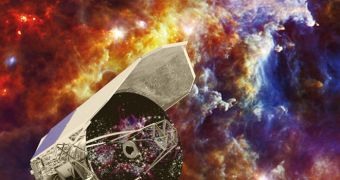Recent data sent back by the European Space Agency's (ESA) Herschel Space Observatory reveal that most of the interstellar gas masses in our galaxy contain the signature of a peculiar chemical. Using its enormous infrared observational power, the largest telescope ever flown to space determined that the gas clouds are permeated by the compound hydrogen fluoride, which is basically a mix of hydrogen and fluorine. Experts believe that investigating this occurrence in more detail could result in developing a better method of keeping track of so-called “hydrogen caches” in the Milky Way, Space reports.
“Hydrogen fluoride may be a more robust tracer of hidden molecular hydrogen than any other molecule used at present,” explains Edwing Bergin, who was a member of the research group that conducted the new study. He is based in the United States, at the University of Michigan in Ann Arbor. The main reason why this chemical can be used as a marker is the fact that it naturally occurs inside all interstellar gas clouds, regardless of how large the structures are. Hydrogen fluoride molecules occur naturally on our planet as well, but only in very specific cases. The US Geological Survey (USGS) reports that the pale yellow gas mostly accompanies ashes resulting from volcanic eruptions.
The fact that these molecules exist in the galaxy is not new. Back in 1997, the Infrared Space Observatory (ISO), also an ESA mission, confirmed its existence as well. However, it was only after researchers analyzed the new Herschel data that they were able to determine that almost all fluorine identified in gas clouds eventually transforms into the compound. The enormous telescope also discovered for the first time the existence of cold hydrogen fluoride. With the new data, tracking hydrogen concentrations in the Universe may become easier than ever.
It is currently estimated that the chemical makes up for about 75 percent of all average matter in the Universe, excluding dark matter and dark energy. But hydrogen can “conceal” itself from astronomers, especially when in gas clouds. The low temperatures here favor the formation of various compounds that disguise the natural signature of the chemicals, rendering it invisible to scientists. Discovering scattered deposits may now become easier due to the fact that hydrogen fluoride is more readily visible.

 14 DAY TRIAL //
14 DAY TRIAL //